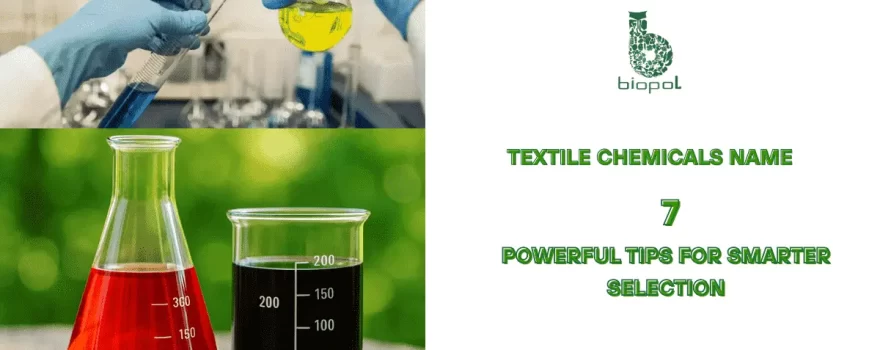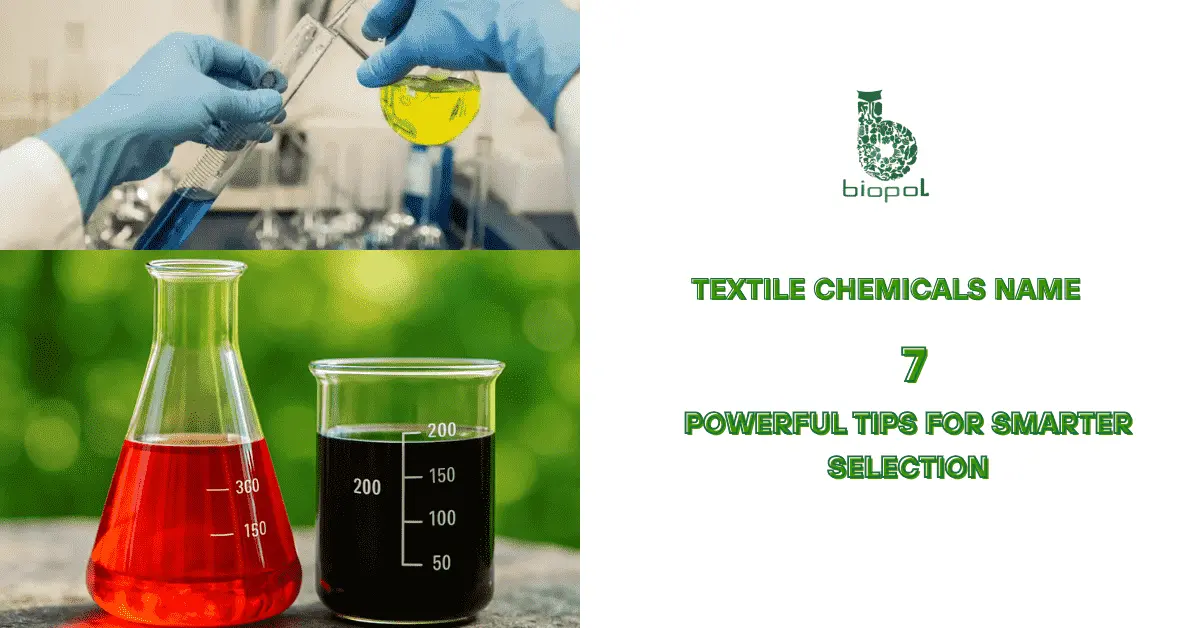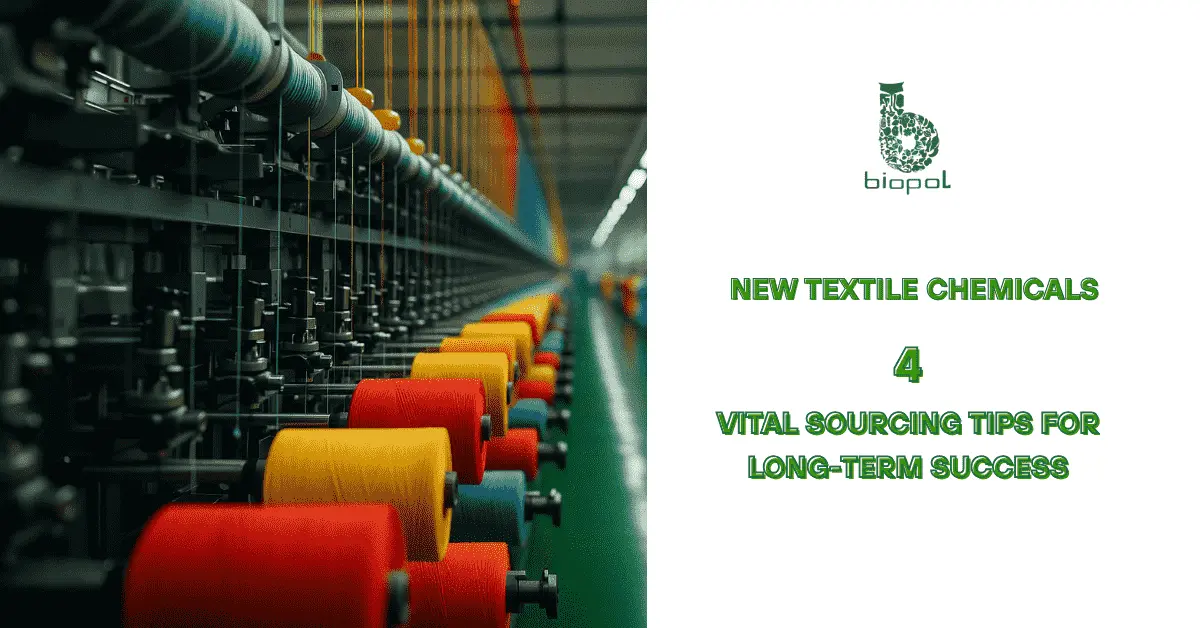
Textile chemicals name is essential for efficient processing, consistent quality, and regulatory compliance. This guide covers functional categories, eco-conscious options, and smart sourcing strategies to help professionals make informed choices. Whether working with cotton, polyester, or blends, selecting the correct name ensures reliable performance across all textile operations.
Table of Contents
Understanding the Industry Basics
The term textile chemicals name refers to specific agents used in fiber treatment, dyeing, printing, and finishing. These names aren’t just identifiers—they define chemical function, regulatory classification, and commercial application. From pre-treatment to finishing, chemicals streamline operations and improve product quality. A clear understanding of these names ensures the right match for each textile process. Accurate naming also helps in sourcing, compliance, and selecting appropriate textile auxiliaries and garment processing agents for industrial use. Grasping these basics is key to operational efficiency and product consistency.
Functional Category
Each textile chemicals name typically aligns with its function in the production process. Common categories include surfactants for reducing surface tension, wetting agents for better water penetration, and color fixatives to lock in dyes. Softening agents improve fabric hand feel, while dispersing agents ensure even dye application. Scouring chemicals remove impurities from raw fibers, and bleaching agents whiten the substrate. Understanding names by function helps manufacturers choose the right chemical at each stage. Functional classification streamlines chemical selection, ensures product quality, and enhances operational control.
Fabric-Specific Textile Chemicals Name
The right textile chemicals name varies by fabric type. Choosing the correct formulation ensures performance and fabric integrity:
- Cotton:
- Enzyme desizers – break down starches from sizing agents.
- Peroxide bleach – whitens and brightens raw cotton.
- Polyester:
- Polyester resins – improve dimensional stability and wrinkle resistance.
- Dispersing agents – aid in dye uniformity during coloration.
- Wool:
- Mild scouring agents – clean without damaging delicate fibers.
- Shrink-proofing agents – prevent felting during washing.
Accurate fabric-specific naming improves consistency, quality, and processing efficiency.
Sustainable Textile Chemicals Name
As sustainability becomes a core priority, knowing the right textile chemicals name for eco-friendly operations is essential. These alternatives reduce water usage, chemical load, and environmental impact:
- Biodegradable chemicals – break down naturally without harming ecosystems.
- Low-impact dyes – require less water and salt, with minimal effluent discharge.
- Enzyme-based scouring agents – replace harsh alkalis in cotton processing.
- Sustainable finishes – include plant-based softeners and non-fluorinated repellents.
Identifying and adopting these green chemical names supports compliance, reduces emissions, and aligns with evolving buyer demands for responsible production.
Industrial Applications
Understanding how each textile chemicals name fits into production tasks helps streamline selection and improve outcomes. Below is a quick reference guide:
| Industrial Task | Common Textile Chemicals Name | Purpose |
| Scouring | Enzyme desizer, Nonionic surfactant | Removes waxes, oils, and sizing agents |
| Bleaching | Hydrogen peroxide, Optical brightener | Whitens fibers and enhances brightness |
| Dyeing | Levelling agent, Dispersing agent | Ensures uniform dye penetration |
| Finishing | Silicone softener, Water repellent resin | Improves texture, feel, and performance |
| Printing | Thickener, Binder | Holds color on fabric surface |
Precise chemical mapping improves industrial fabric care, ensures consistency, and optimizes chemical treatment performance.
Here’s a shortened version of that heading:
Trade vs Generic Textile Chemicals Name
Understanding the distinction between chemical brand names and generic textile chemicals is key for making informed purchasing decisions:
Chemical Brand Names:
Proprietary labels assigned by manufacturers (e.g., silicone-based softeners under brand names).
May offer access to exclusive formulations, technical documentation, and application guidance.
Typically priced higher due to branding and proprietary R&D investments.
- Generic Textile Chemicals:
- Descriptive names based on chemical function (e.g., sodium hydroxide, polyester resin).
- More cost-effective and widely available from multiple suppliers.
May lack proprietary formulations or performance guarantees.
Knowing both types helps balance quality and cost in sourcing decisions.
Choosing Right Textile Chemicals Name
Choosing the correct textile chemical name is crucial for optimizing operational processes, maintaining high product quality, and adhering to regulatory standards. Here’s a quick guide to help:
- Textile Formulation:
- Industrial Grade:
- Opt for industrial-grade chemicals for consistency in large-scale production.
- Ensure the chemical meets strength and purity requirements.
- Compliance and Certification:
- Verify compliance with industry standards (e.g., OEKO-TEX, REACH).
- Check for certifications that confirm safety and sustainability.
- Supplier Reputation:
- Choose suppliers with a strong reputation and technical support.
- Ensure chemicals come with clear safety and usage documentation
By following these criteria, you can ensure both textile manufacturing success and long-term operational stability.
Sourcing Trusted Textile Chemicals
When sourcing textile chemicals name for industrial applications, it’s essential to partner with reliable suppliers to ensure quality and compliance:
When sourcing textile chemicals name for industrial applications, it’s essential to partner with reliable suppliers to ensure quality and compliance:
Textile Chemical Suppliers:
Seek out trusted suppliers with a proven history of reliability in the textile industry. Ensure they have certifications like ISO or REACH compliance.
Choose suppliers that prioritize transparency, ensuring they provide comprehensive chemical composition details and safety data sheets (SDS).
Sourcing Chemicals:
Source chemicals through established trade platforms or direct relationships with manufacturers. This guarantees that the chemicals align perfectly with your specific requirements.
Consider working with local distributors who offer timely delivery and customer support.
Textile Inputs:
Collaborate with suppliers who offer complete textile solutions, including technical advice on formulation and application.
Call-to-action: Ensure the quality and performance of your products by choosing trusted, certified suppliers. Start sourcing your textile chemicals today by reaching out to vetted solution partners who understand your business needs.
FAQs for Textile Chemicals Name
What Are Textile Chemicals?
In the textile industry, chemicals are utilized to treat fibers, yarns, and fabrics, enhancing their performance and quality. They help in processes like dyeing, finishing, and fabric enhancement (e.g., softeners, dyes, water repellents).
Why Are Textile Chemicals Names Important?
The name of a textile chemical often reflects its function, composition, and usage. It helps manufacturers identify the right product for specific applications and ensures consistent product quality.
What Are the Different Categories of Textile Chemicals?
Textile chemicals are broadly categorized into dyes, finishing agents, softeners, enzymes, bleaching agents, and scouring agents. Each category has specific functions, like enhancing fabric performance or improving color quality.
How Do I Choose the Right Textile Chemical for My Fabric?
When selecting a textile chemical, consider factors like fabric type (e.g., cotton, polyester), desired finish (e.g., softening, water repellency), and whether the chemical is industrial-grade or meets regulatory standards.
Are There Eco-Friendly Textile Chemicals Available?
Yes, eco-friendly textile chemicals are increasingly available. These include biodegradable chemicals, low-impact dyes, and plant-based finishes, designed to minimize environmental impact while maintaining fabric quality.
How Do I Ensure the Quality of Textile Chemicals?
Ensure that the textile chemical supplier offers quality products by checking certifications like OEKO-TEX or REACH compliance. Request safety data sheets (SDS) and inquire about product performance guarantees.
Can I Buy Textile Chemicals in Bulk?
Yes, textile chemicals are often sold in bulk quantities, especially for large-scale production. It’s advisable to work with a reputable supplier for bulk orders to ensure timely delivery, consistent product quality, and reliable technical support. Trusted suppliers also help reduce risks related to compliance and supply chain disruptions.
Are Textile Chemicals Regulated?
Yes, textile chemicals are regulated by industry standards and environmental laws. Compliance frameworks like REACH, OEKO-TEX, and local safety regulations govern the safe usage, labeling, and disposal of these chemicals to protect both workers and the environment.
How Can I Find Trusted Textile Chemical Suppliers?
Look for suppliers with a good industry reputation, positive customer reviews, and certification for quality and sustainability. Trusted suppliers will offer technical support and clear documentation for each product.

